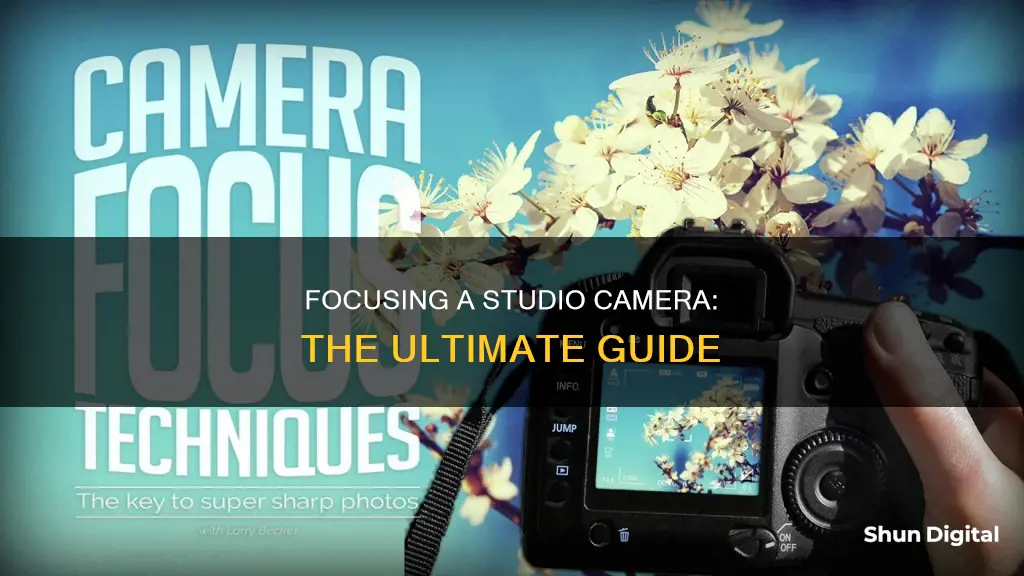
Focusing a studio camera is a critical skill for any level of video production. The ability to focus a camera properly can make or break a shot. While autofocus is available on most cameras, it is important to understand how to focus manually. To focus a studio camera, locate the focus control, usually a manual focus ring near the front of the lens housing, and adjust the focus ring until the picture is sharp. The direction in which the ring is turned depends on the desired focus distance, with a clockwise turn for closer focus and anti-clockwise for more distant focus. It is also important to ensure the camera is set to manual focus before adjusting the focus ring. Additionally, the depth of field, or the range of distances at which a sharp focus can be obtained, should be considered. A shallow depth of field can be used to isolate a subject in the frame, while a deep depth of field allows the audience to see everything at once.
What You'll Learn

Understand the different types of camera focus
Camera focus is about more than just creating a sharp image. It can also be used as a storytelling device, conveying the emotion of a scene or guiding the viewer's eye to something specific.
Deep Focus
Deep focus is when everything in the frame is in focus, from the foreground to the background. This technique allows the audience to see everything at once and can be used to immerse them in the story and environment. It also enables camera movement, creating dynamic frame compositions. An example of deep focus can be seen in the film Citizen Kane.
Shallow Depth of Field
Shallow depth of field is when the subject is in focus while the background is blurry. This technique can be used to direct the viewer's attention to a specific object or person and to convey emotion. It can also be used to hide things on set that you don't want the viewer to see. Shallow depth of field can be achieved by using lower aperture settings, increasing the lens focal length, or changing the distance between the camera and the subject.
Soft Focus
Soft focus affects the entire image, creating a "soft" blur or glow around the subject. It gives the image a dreamy or slightly unreal quality and is often used in dream sequences or flashbacks. Soft focus shots can be achieved by using special lenses or filters, or by using DIY methods such as smudging the lens with Vaseline or stretching nylon across it.
Rack Focus
Rack focus is when the camera changes focus from one subject to another during a shot. This technique can be used to shift the viewer's attention and keep them engaged. It can also be used to save time on set by eliminating the need for multiple shots. Rack focus can be achieved with a manual focus setup or with autofocus on certain cameras.
Split Diopter
A split diopter lens creates two separate shallow focal planes in a single shot, allowing for focus on multiple planes. This technique can lend a sense of juxtaposition or fantasy to a film but can also pull the viewer out of the movie as it creates an "impossible" image that the human eye cannot replicate.
Tilt-Shift
Tilt-shift lenses manipulate the perception of an object or subject by tilting or shifting the lens in relation to the focus. This technique can be used to control perspective, minimise or maximise the depth of field, and make objects appear miniature. It is often used in architectural photography to eliminate unsightly angles.
Are Batteries Included? Camera Shopping Basics
You may want to see also

Know how to use manual focus
Manual focus is a critical skill to have when operating a studio camera. It is important to know how to use manual focus because it gives you more control over your images and can help you achieve the desired results. Here are some tips on how to use manual focus effectively:
- Locate the focus control: On professional cameras, the manual focus ring is usually near the front of the lens housing. On consumer-level cameras, it is typically a small dial, and you may need to select "manual focus" from the menu.
- Set the camera to manual focus: Ensure that the camera is set to manual focus mode before adjusting the focus. This is usually done by flipping a switch on the lens or selecting the option from the camera's menu.
- Zoom in on the subject: Before adjusting the focus, zoom in as tight as you can on the subject you want to focus on.
- Adjust the focus ring: Turn the focus ring until the picture is sharp. Remember that turning the ring clockwise will bring the focus closer, while turning it anti-clockwise will move the focus farther away.
- Zoom out and check the focus: After adjusting the focus, zoom out to the required framing. The picture should remain sharp. If it loses focus, check the back-focus and ensure that the macro focus is not engaged.
- Practice: Manual focus is a skill that requires practice and dexterity, especially when working with moving subjects. The more you practice, the better your intuition will become for adjusting the focus ring.
- Use the diopter adjustment: Adjust the diopter (usually a wheel on the side of your viewfinder) to match your eyesight. This will make it easier to focus manually, as you'll be able to see the scene more clearly and sharply.
- Use live view or magnification: Many cameras have a live view mode that allows you to see a live feed of the sensor on the LCD screen. You can magnify the image to fine-tune the focus and ensure perfect sharpness. Some cameras also offer magnification of the scene as you rotate the focusing ring, providing a better view of what is in focus.
- Understand depth of field: Depth of field refers to the "in-focus" areas of an image. It is important to understand this concept when using manual focus, as it determines how much of your image will be sharp.
- Use focus peaking: Many modern cameras have a focus peaking feature that outlines objects in focus with bright colours. This can be very helpful when using manual focus, especially with fast lenses that have a narrow depth of field.
- Know when to use manual focus: While manual focus is a valuable skill, it is not always the best option. It is most useful in low-light conditions, when dealing with low-contrast scenes or subjects, when there are obstructions between you and the subject, or when shooting video with older manual focus lenses. In fast-paced or action-packed scenes, autofocus is usually more reliable.
Shipping a Camera With Battery: The Safe Way
You may want to see also

Learn about depth of field
Depth of field (DoF) is a key concept in photography and cinematography, and understanding it will help you create stunning and artistic images.
Depth of field refers to the area of a photograph that appears acceptably sharp and in focus. It is the zone of sharpness within a photo. In every picture, there is a point of focus where you focus your lens, and the depth of field is the area in front of and behind this point that also appears sharp. The transition from sharp to unsharp is gradual, and what is considered 'acceptably sharp' can vary depending on how the image will be viewed and the viewer's eyesight.
Depth of field can be thought of as a spectrum, with a shallow depth of field at one end and a deep depth of field at the other.
Shallow vs Deep Depth of Field
A shallow depth of field means only a small slice of the image is in focus, with the background rendered as a smooth blur. This is often used in portrait photography to draw attention to the subject and prevent background distractions. It can also be used to elicit certain emotions from viewers, such as severity, loneliness, or fear.
On the other hand, a deep depth of field means a larger area of the image is in focus, with sharp details from the foreground to the background. This is commonly used in landscape photography to showcase every detail of the scene.
Factors Affecting Depth of Field
There are several factors that determine the depth of field in a photo:
- Aperture setting (f-stop): Aperture refers to the opening in your lens that lets light in, similar to the pupil in a human eye. A larger aperture results in a shallower depth of field, while a smaller aperture creates a deeper depth of field.
- Distance to the subject: The closer your subject is to the camera, the shallower the depth of field. This is true regardless of the focal length of your lens.
- Focal length of the lens: Longer lenses produce shallower depth of field effects, while shorter lenses result in deeper depth of field.
Controlling Depth of Field
By adjusting these three factors, you can control the depth of field in your images. Here are some tips for achieving the desired effect:
- For a shallow depth of field, use a longer lens, set a wide aperture, and get close to your subject.
- For a deep depth of field, use a wide-angle lens, narrow aperture, and move farther away from your subject.
- Use a hyperfocal distance calculator or app to determine the exact depth of field for a given focal length.
- Experiment with different aperture settings and evaluate the results to find the best depth of field for a particular scene.
Depth of Field in Cameras
The depth of field can be governed or controlled in several ways:
- Aperture: As mentioned earlier, adjusting the aperture can change the depth of field. A wider aperture creates a shallower depth of field, while a narrower aperture results in a deeper depth of field.
- Camera sensor size: Larger camera sensors decrease the depth of field as you need to move closer to your subject to fill the frame.
- Camera-to-subject distance: The physical distance between the camera and the subject also affects the depth of field. Moving closer to the subject results in a shallower depth of field.
By understanding and manipulating these factors, photographers and cinematographers can achieve precise control over their images, enhancing the visual storytelling and artistic impact of their work.
Do Red-Light Cameras Affect Insurance in Washington State?
You may want to see also

Explore autofocus modes
Autofocus modes are a fantastic feature of modern cameras, allowing you to capture sharp images without the need to manually focus. However, autofocus doesn't always get it right, and sometimes you may need to take control. Understanding the different autofocus modes available to you will help you to capture the perfect shot.
Continuous Focusing Mode
Continuous focus mode is ideal for keeping moving objects sharp as you track them. As soon as you depress the shutter release, the camera begins to focus, detecting the subject's movements and adjusting focus accordingly. This mode is battery-intensive, as the camera is continuously focusing and refocusing. It may also struggle to predict the direction of fast-moving subjects, resulting in blur.
One Shot Focusing Mode
Also known as single-focus mode, this mode saves battery power and is perfect for capturing stationary subjects. The camera focuses on the subject once when you depress the shutter release, with no continuous adjustment. This mode falls short when trying to capture moving subjects.
Automatic Autofocus Mode
This mode is a relatively new feature, with the camera's focusing computer jumping between continuous and single-focus modes depending on the situation. This is the default autofocus mode on many cameras. Automatic autofocus is useful when you're unsure what's going to happen next and want the camera to make quick adjustments.
Manual Focusing Mode
Manual focus is often considered a frustrating barrier to great photography. It requires the use of distance measurements on the lens barrel and even tape measures to achieve perfect focus. However, it gives you complete control over the focus, allowing you to draw attention to specific subjects or create a dream-like quality to your images.
Single-Point Mode
Single-point mode is available on many DSLR cameras, allowing you to do single-shot or continuous autofocus on a single focus point. You pick one focus point, and the camera looks for contrast only at that point. This mode is ideal for stationary subjects such as landscapes and architecture.
Group Mode
Group mode activates several focus points and evaluates the information from that cluster. It's particularly useful for action shooting, as it strives to keep tracking the subject even if the central point loses track. Some cameras use this mode to recognise and track the nearest eye.
Dynamic Mode
Dynamic mode is similar to group mode, locking onto a single point and then tracking the object if it moves to surrounding points. The camera assumes you'll try to keep the object in the same spot and adjusts the focus points accordingly.
Automatic Mode
In automatic mode, the camera uses all its focusing power to do the work for you. It may search for skin tones and lock onto a person or evaluate information from multiple points to focus on the nearest object. This mode is useful if you want to focus on composition rather than manual focusing.
Charging Yi 4K Action Camera: A Step-by-Step Guide
You may want to see also

Practice focusing in different conditions
Focusing a camera is a skill that takes time to master. It is important to practice focusing in different conditions to improve your photography skills.
Focusing in low-light conditions can be challenging. Cameras struggle to autofocus in low light, and it can be difficult for you too. In such situations, using the live view feature can help you zoom in on the scene and focus more accurately. If it is too dark, you may need to use additional lighting equipment, such as a headlight, torch, or lamp.
Another tricky situation is capturing fast-moving subjects. The best way to handle this is by using continuous autofocus with the auto-area mode. This allows the camera to automatically refocus on the subject as it moves. If you are standing still, the dynamic area mode can help you track and follow the subject with your camera.
When shooting in the field, it is not always possible to measure the exact distance to the subject. In such cases, you can estimate the distance and adjust the focus using the LCD screen.
Additionally, when shooting with shallow depth of field, it is important to maintain the correct distance between the camera and the subject. If the subject moves outside the specified range, the image will become unfocused.
By practicing focusing in these different conditions, you will improve your photography skills and be able to capture sharp and focused images in any situation.
Fight Back: Beating Speeding Ticket Cameras
You may want to see also
Frequently asked questions
First, locate the focus control. Professional cameras usually have a manual focus ring near the front of the lens housing. Then, make sure the camera is set to manual focus. Adjust the focus ring until the picture is sharp. Turn the ring clockwise for a closer focus, and anti-clockwise for a more distant focus.
Most modern cameras have autofocus motors built into the lenses, which are controlled from the camera itself. The autofocus camera calculates focus electronically as the lens moves toward and away from the sensor or film.
Active AF systems rely on the camera transmitting an ultrasonic or infrared signal toward the subject. The subject reflects the sound or light back to the camera’s focus sensor and, by calculating the time it took for the signal to return, the camera can work out how far away the subject is. Passive AF, on the other hand, has two systems: Phase Detection and Contrast Detection. Phase Detection is most commonly found on DSLR cameras and involves dividing the incoming light into pairs of images and comparing them. Contrast Detection is used by mirrorless cameras, point-and-shoot cameras, and smartphone cameras. It uses the light falling on the main sensor to focus.







